Finance for Decision Making Report: Greengrass Ltd. Analysis
VerifiedAdded on 2022/11/29
|7
|1187
|157
Report
AI Summary
This finance report analyzes the financial performance of Greengrass Ltd., a company manufacturing robotic lawnmowers. The report includes a break-even analysis, calculating the break-even sales price per unit, break-even in units, and the margin of safety, revealing the company's safe operational position. It then delves into absorption costing, outlining its advantages and disadvantages, and compares it with activity-based costing (ABC), highlighting the benefits of ABC in terms of cost accuracy, cost behavior data, and cost management. The report also assesses the impact of current pricing strategies on sales revenue and discusses key financial performance indicators (KPIs) and selective performance measures (APMs), providing a comprehensive overview of the company's financial health and strategic insights for decision-making. The report is based on the provided assignment brief which includes details about the company and its products.

Finance & Accounting
Paraphrase This Document
Need a fresh take? Get an instant paraphrase of this document with our AI Paraphraser
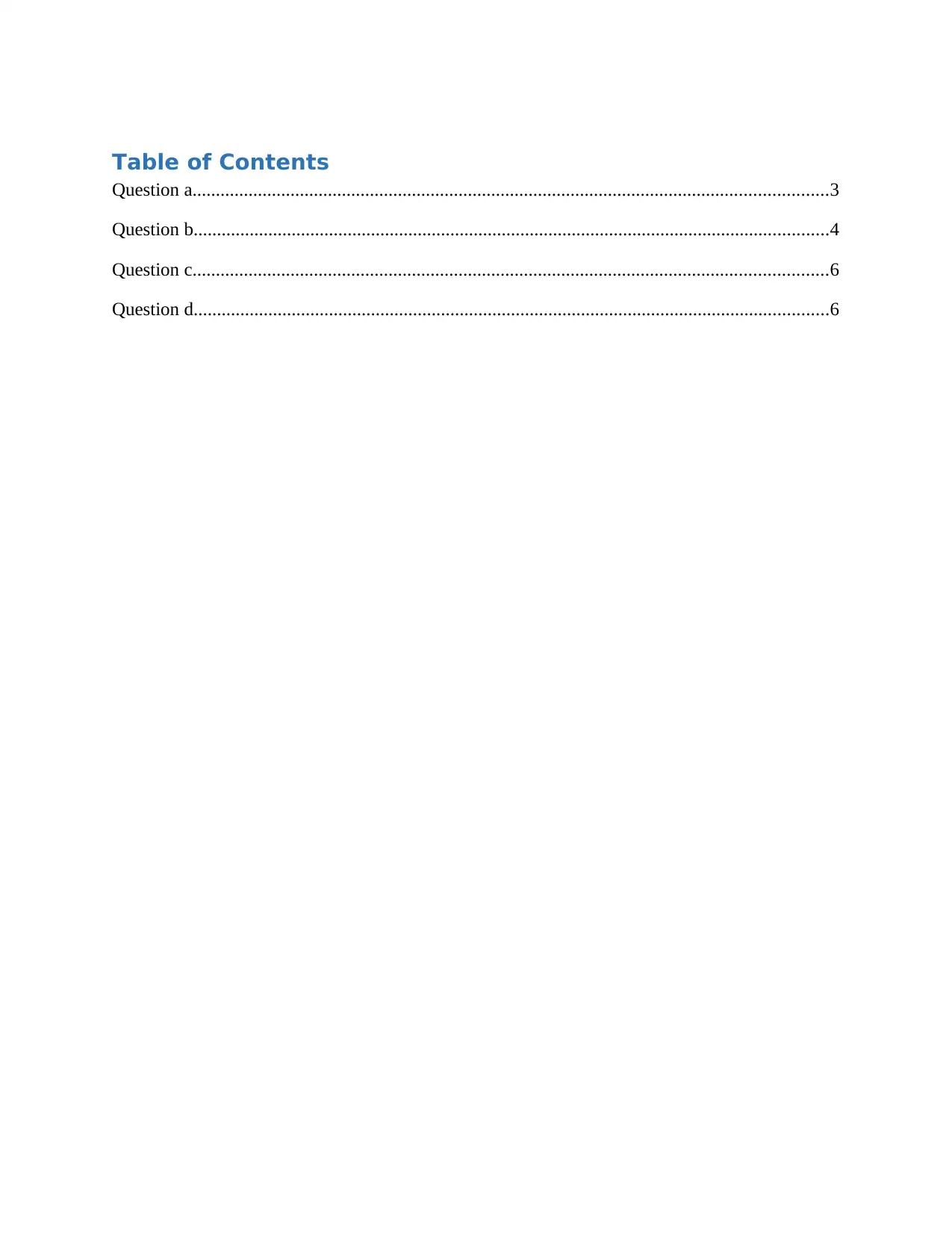
Table of Contents
Question a........................................................................................................................................3
Question b........................................................................................................................................4
Question c........................................................................................................................................6
Question d........................................................................................................................................6
Question a........................................................................................................................................3
Question b........................................................................................................................................4
Question c........................................................................................................................................6
Question d........................................................................................................................................6
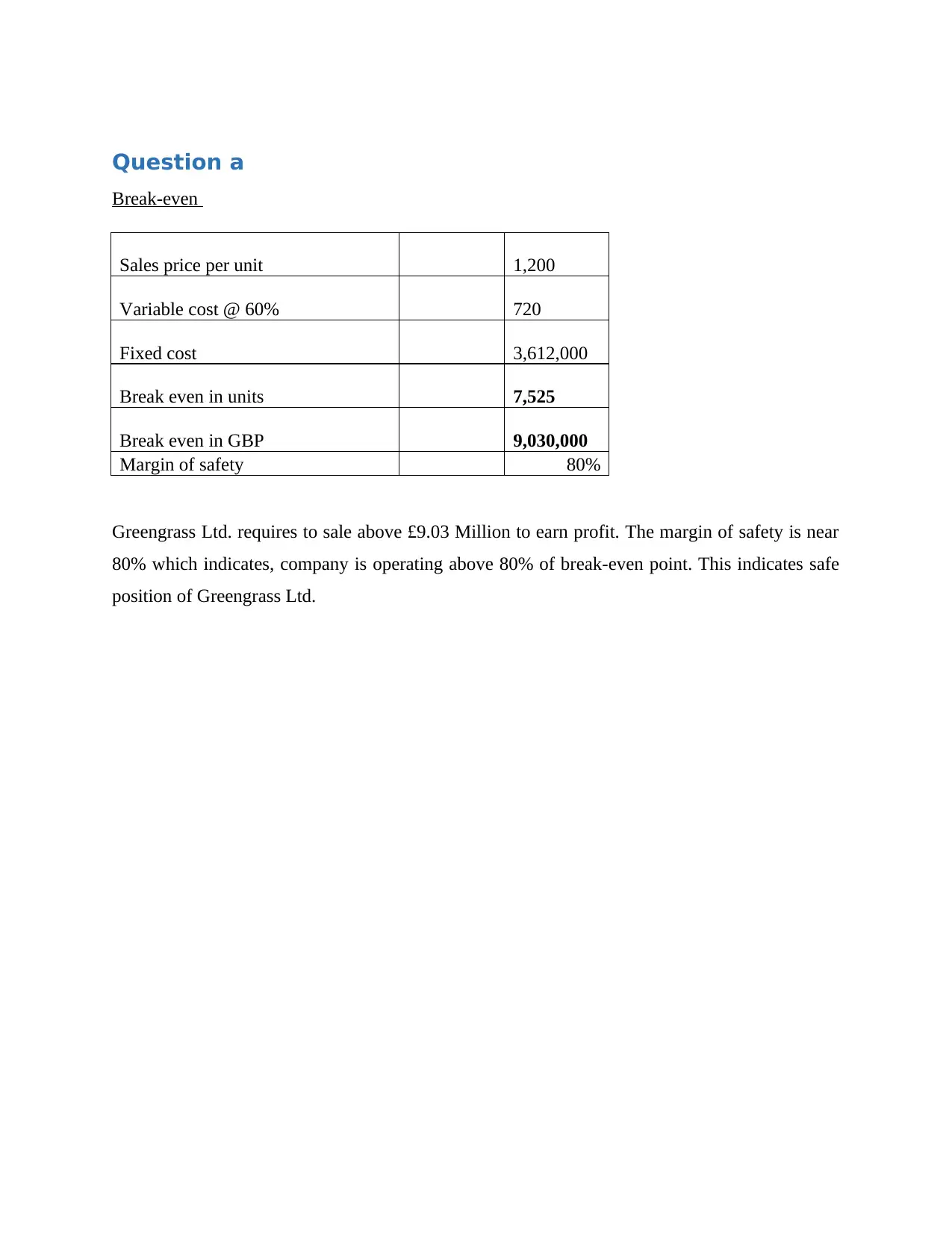
Question a
Break-even
Sales price per unit 1,200
Variable cost @ 60% 720
Fixed cost 3,612,000
Break even in units 7,525
Break even in GBP 9,030,000
Margin of safety 80%
Greengrass Ltd. requires to sale above £9.03 Million to earn profit. The margin of safety is near
80% which indicates, company is operating above 80% of break-even point. This indicates safe
position of Greengrass Ltd.
Break-even
Sales price per unit 1,200
Variable cost @ 60% 720
Fixed cost 3,612,000
Break even in units 7,525
Break even in GBP 9,030,000
Margin of safety 80%
Greengrass Ltd. requires to sale above £9.03 Million to earn profit. The margin of safety is near
80% which indicates, company is operating above 80% of break-even point. This indicates safe
position of Greengrass Ltd.
⊘ This is a preview!⊘
Do you want full access?
Subscribe today to unlock all pages.

Trusted by 1+ million students worldwide
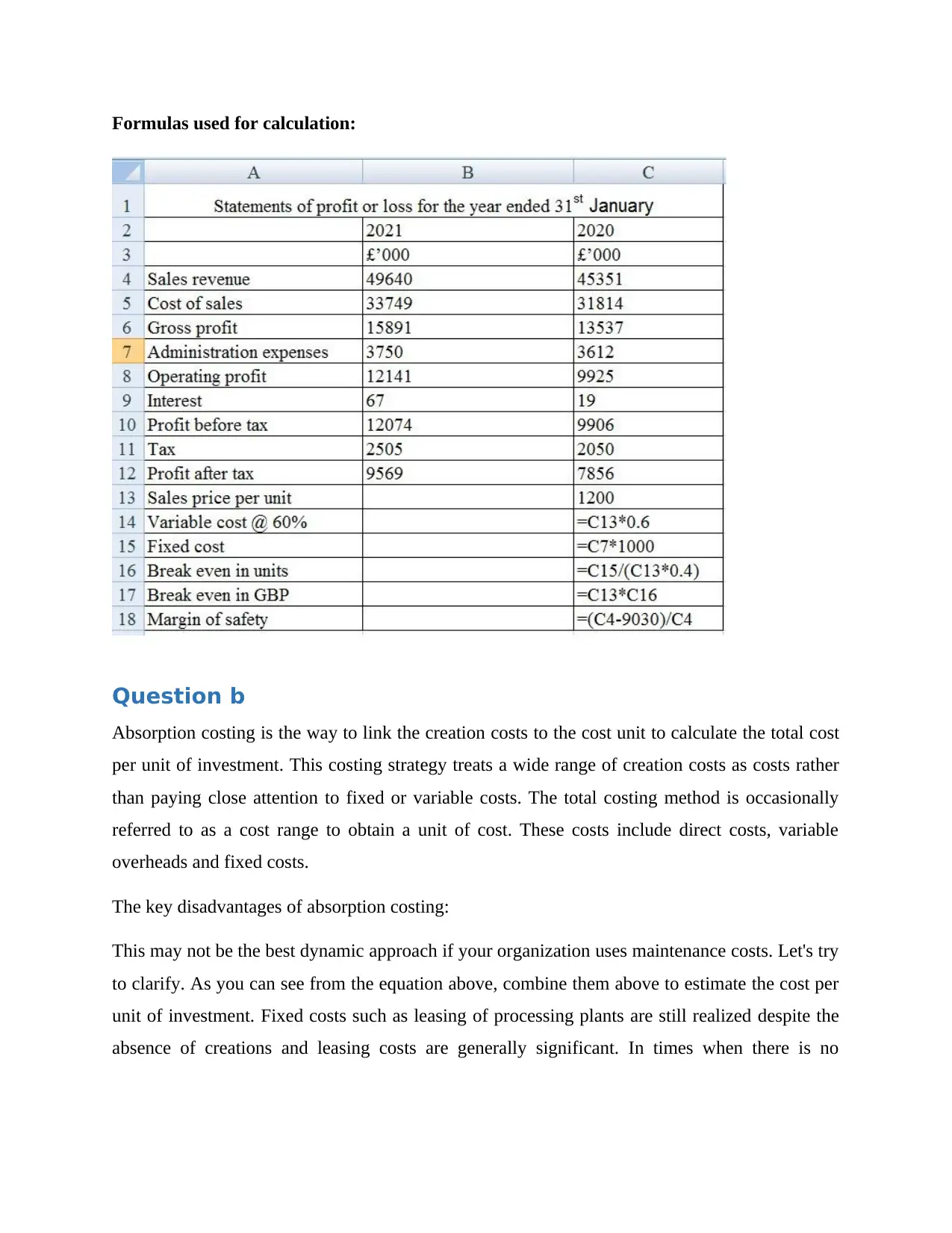
Formulas used for calculation:
Question b
Absorption costing is the way to link the creation costs to the cost unit to calculate the total cost
per unit of investment. This costing strategy treats a wide range of creation costs as costs rather
than paying close attention to fixed or variable costs. The total costing method is occasionally
referred to as a cost range to obtain a unit of cost. These costs include direct costs, variable
overheads and fixed costs.
The key disadvantages of absorption costing:
This may not be the best dynamic approach if your organization uses maintenance costs. Let's try
to clarify. As you can see from the equation above, combine them above to estimate the cost per
unit of investment. Fixed costs such as leasing of processing plants are still realized despite the
absence of creations and leasing costs are generally significant. In times when there is no
Question b
Absorption costing is the way to link the creation costs to the cost unit to calculate the total cost
per unit of investment. This costing strategy treats a wide range of creation costs as costs rather
than paying close attention to fixed or variable costs. The total costing method is occasionally
referred to as a cost range to obtain a unit of cost. These costs include direct costs, variable
overheads and fixed costs.
The key disadvantages of absorption costing:
This may not be the best dynamic approach if your organization uses maintenance costs. Let's try
to clarify. As you can see from the equation above, combine them above to estimate the cost per
unit of investment. Fixed costs such as leasing of processing plants are still realized despite the
absence of creations and leasing costs are generally significant. In times when there is no
Paraphrase This Document
Need a fresh take? Get an instant paraphrase of this document with our AI Paraphraser
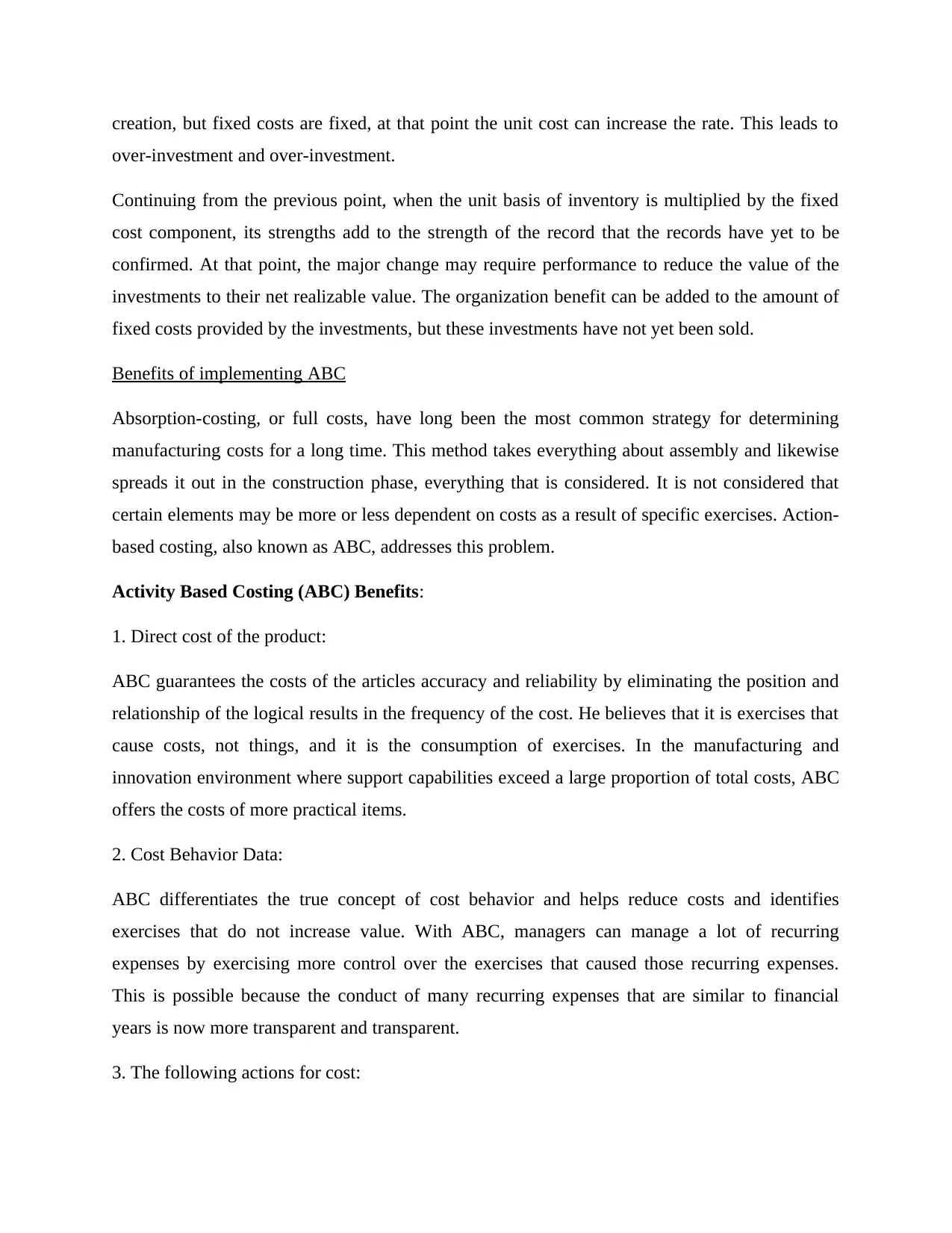
creation, but fixed costs are fixed, at that point the unit cost can increase the rate. This leads to
over-investment and over-investment.
Continuing from the previous point, when the unit basis of inventory is multiplied by the fixed
cost component, its strengths add to the strength of the record that the records have yet to be
confirmed. At that point, the major change may require performance to reduce the value of the
investments to their net realizable value. The organization benefit can be added to the amount of
fixed costs provided by the investments, but these investments have not yet been sold.
Benefits of implementing ABC
Absorption-costing, or full costs, have long been the most common strategy for determining
manufacturing costs for a long time. This method takes everything about assembly and likewise
spreads it out in the construction phase, everything that is considered. It is not considered that
certain elements may be more or less dependent on costs as a result of specific exercises. Action-
based costing, also known as ABC, addresses this problem.
Activity Based Costing (ABC) Benefits:
1. Direct cost of the product:
ABC guarantees the costs of the articles accuracy and reliability by eliminating the position and
relationship of the logical results in the frequency of the cost. He believes that it is exercises that
cause costs, not things, and it is the consumption of exercises. In the manufacturing and
innovation environment where support capabilities exceed a large proportion of total costs, ABC
offers the costs of more practical items.
2. Cost Behavior Data:
ABC differentiates the true concept of cost behavior and helps reduce costs and identifies
exercises that do not increase value. With ABC, managers can manage a lot of recurring
expenses by exercising more control over the exercises that caused those recurring expenses.
This is possible because the conduct of many recurring expenses that are similar to financial
years is now more transparent and transparent.
3. The following actions for cost:
over-investment and over-investment.
Continuing from the previous point, when the unit basis of inventory is multiplied by the fixed
cost component, its strengths add to the strength of the record that the records have yet to be
confirmed. At that point, the major change may require performance to reduce the value of the
investments to their net realizable value. The organization benefit can be added to the amount of
fixed costs provided by the investments, but these investments have not yet been sold.
Benefits of implementing ABC
Absorption-costing, or full costs, have long been the most common strategy for determining
manufacturing costs for a long time. This method takes everything about assembly and likewise
spreads it out in the construction phase, everything that is considered. It is not considered that
certain elements may be more or less dependent on costs as a result of specific exercises. Action-
based costing, also known as ABC, addresses this problem.
Activity Based Costing (ABC) Benefits:
1. Direct cost of the product:
ABC guarantees the costs of the articles accuracy and reliability by eliminating the position and
relationship of the logical results in the frequency of the cost. He believes that it is exercises that
cause costs, not things, and it is the consumption of exercises. In the manufacturing and
innovation environment where support capabilities exceed a large proportion of total costs, ABC
offers the costs of more practical items.
2. Cost Behavior Data:
ABC differentiates the true concept of cost behavior and helps reduce costs and identifies
exercises that do not increase value. With ABC, managers can manage a lot of recurring
expenses by exercising more control over the exercises that caused those recurring expenses.
This is possible because the conduct of many recurring expenses that are similar to financial
years is now more transparent and transparent.
3. The following actions for cost:
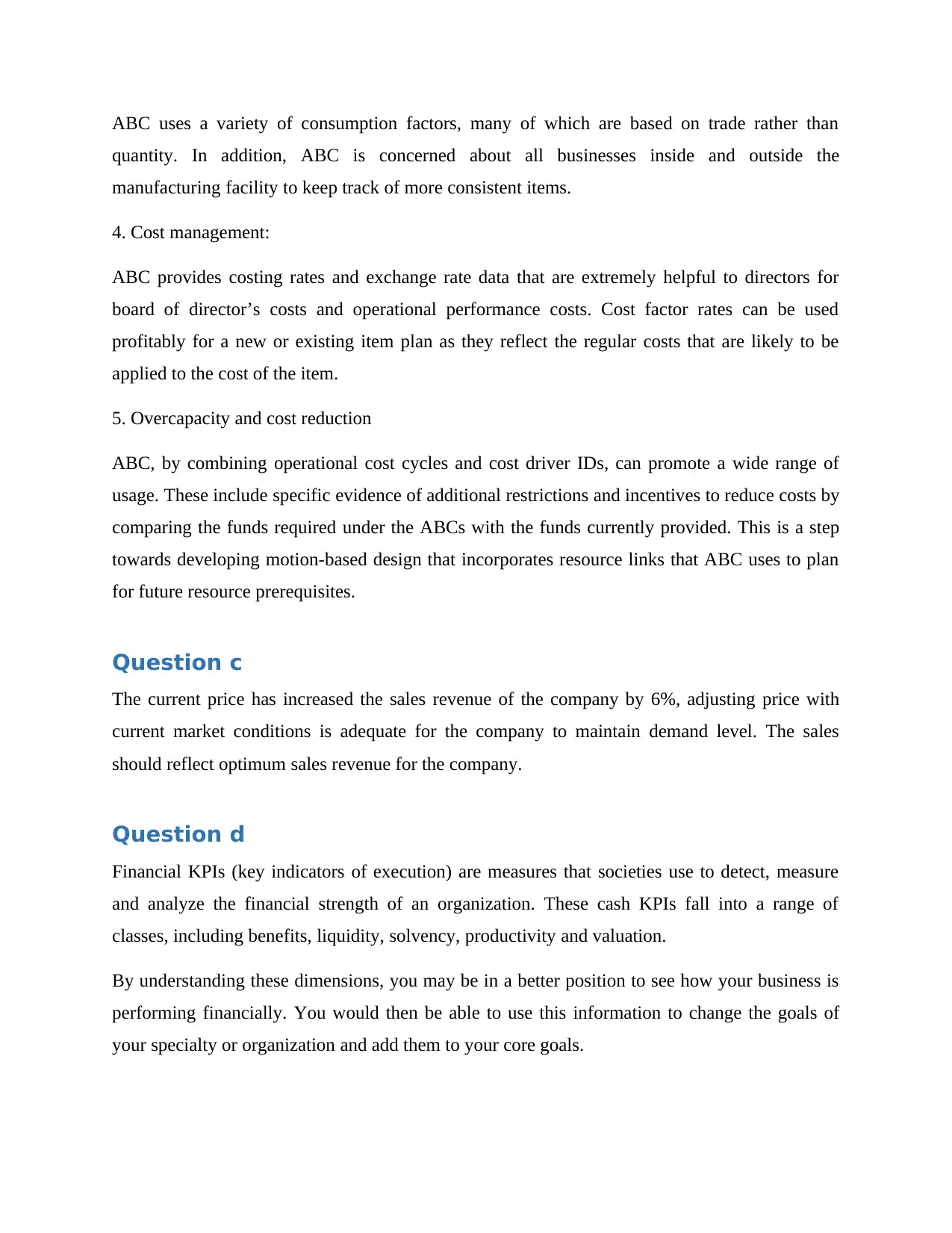
ABC uses a variety of consumption factors, many of which are based on trade rather than
quantity. In addition, ABC is concerned about all businesses inside and outside the
manufacturing facility to keep track of more consistent items.
4. Cost management:
ABC provides costing rates and exchange rate data that are extremely helpful to directors for
board of director’s costs and operational performance costs. Cost factor rates can be used
profitably for a new or existing item plan as they reflect the regular costs that are likely to be
applied to the cost of the item.
5. Overcapacity and cost reduction
ABC, by combining operational cost cycles and cost driver IDs, can promote a wide range of
usage. These include specific evidence of additional restrictions and incentives to reduce costs by
comparing the funds required under the ABCs with the funds currently provided. This is a step
towards developing motion-based design that incorporates resource links that ABC uses to plan
for future resource prerequisites.
Question c
The current price has increased the sales revenue of the company by 6%, adjusting price with
current market conditions is adequate for the company to maintain demand level. The sales
should reflect optimum sales revenue for the company.
Question d
Financial KPIs (key indicators of execution) are measures that societies use to detect, measure
and analyze the financial strength of an organization. These cash KPIs fall into a range of
classes, including benefits, liquidity, solvency, productivity and valuation.
By understanding these dimensions, you may be in a better position to see how your business is
performing financially. You would then be able to use this information to change the goals of
your specialty or organization and add them to your core goals.
quantity. In addition, ABC is concerned about all businesses inside and outside the
manufacturing facility to keep track of more consistent items.
4. Cost management:
ABC provides costing rates and exchange rate data that are extremely helpful to directors for
board of director’s costs and operational performance costs. Cost factor rates can be used
profitably for a new or existing item plan as they reflect the regular costs that are likely to be
applied to the cost of the item.
5. Overcapacity and cost reduction
ABC, by combining operational cost cycles and cost driver IDs, can promote a wide range of
usage. These include specific evidence of additional restrictions and incentives to reduce costs by
comparing the funds required under the ABCs with the funds currently provided. This is a step
towards developing motion-based design that incorporates resource links that ABC uses to plan
for future resource prerequisites.
Question c
The current price has increased the sales revenue of the company by 6%, adjusting price with
current market conditions is adequate for the company to maintain demand level. The sales
should reflect optimum sales revenue for the company.
Question d
Financial KPIs (key indicators of execution) are measures that societies use to detect, measure
and analyze the financial strength of an organization. These cash KPIs fall into a range of
classes, including benefits, liquidity, solvency, productivity and valuation.
By understanding these dimensions, you may be in a better position to see how your business is
performing financially. You would then be able to use this information to change the goals of
your specialty or organization and add them to your core goals.
⊘ This is a preview!⊘
Do you want full access?
Subscribe today to unlock all pages.

Trusted by 1+ million students worldwide
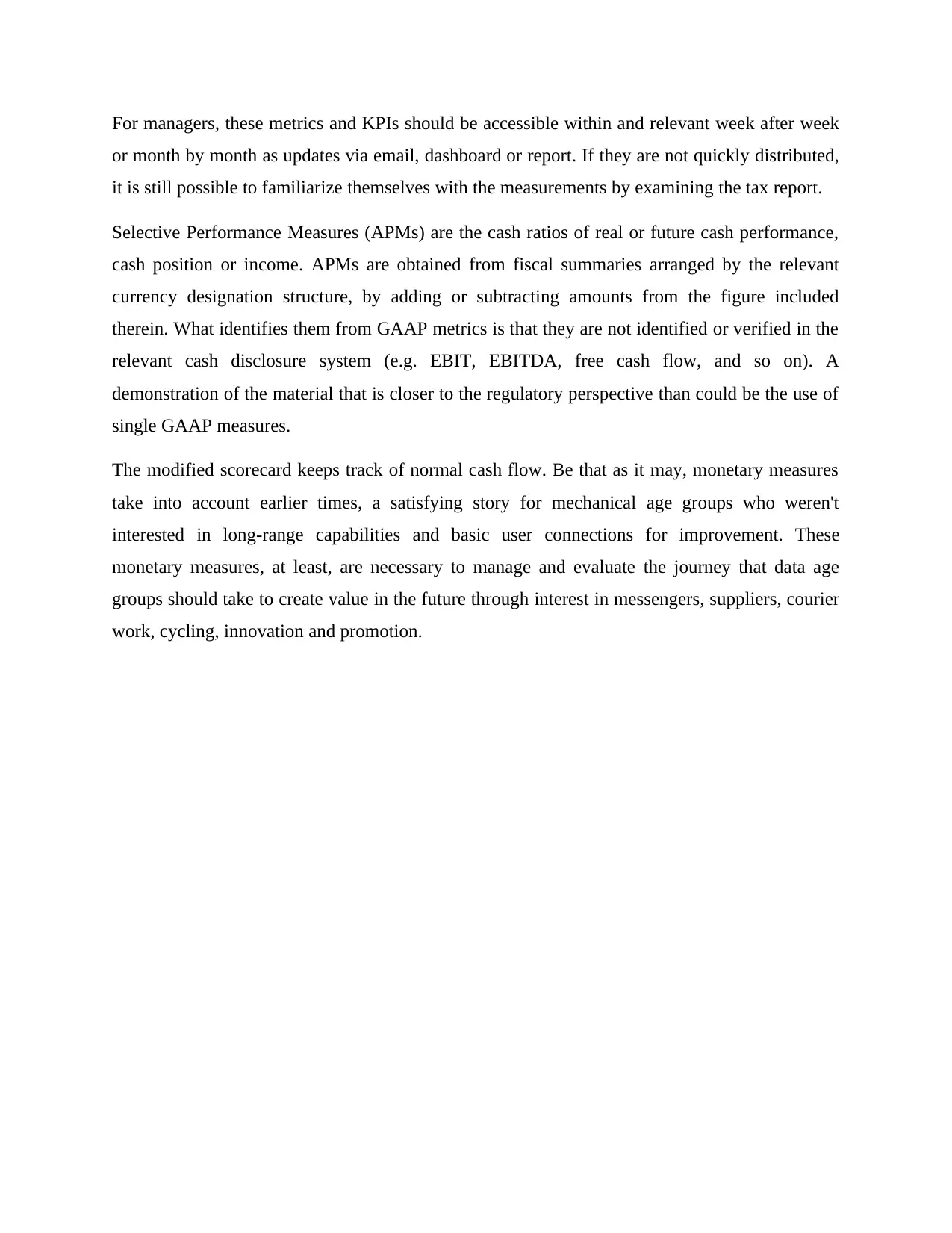
For managers, these metrics and KPIs should be accessible within and relevant week after week
or month by month as updates via email, dashboard or report. If they are not quickly distributed,
it is still possible to familiarize themselves with the measurements by examining the tax report.
Selective Performance Measures (APMs) are the cash ratios of real or future cash performance,
cash position or income. APMs are obtained from fiscal summaries arranged by the relevant
currency designation structure, by adding or subtracting amounts from the figure included
therein. What identifies them from GAAP metrics is that they are not identified or verified in the
relevant cash disclosure system (e.g. EBIT, EBITDA, free cash flow, and so on). A
demonstration of the material that is closer to the regulatory perspective than could be the use of
single GAAP measures.
The modified scorecard keeps track of normal cash flow. Be that as it may, monetary measures
take into account earlier times, a satisfying story for mechanical age groups who weren't
interested in long-range capabilities and basic user connections for improvement. These
monetary measures, at least, are necessary to manage and evaluate the journey that data age
groups should take to create value in the future through interest in messengers, suppliers, courier
work, cycling, innovation and promotion.
or month by month as updates via email, dashboard or report. If they are not quickly distributed,
it is still possible to familiarize themselves with the measurements by examining the tax report.
Selective Performance Measures (APMs) are the cash ratios of real or future cash performance,
cash position or income. APMs are obtained from fiscal summaries arranged by the relevant
currency designation structure, by adding or subtracting amounts from the figure included
therein. What identifies them from GAAP metrics is that they are not identified or verified in the
relevant cash disclosure system (e.g. EBIT, EBITDA, free cash flow, and so on). A
demonstration of the material that is closer to the regulatory perspective than could be the use of
single GAAP measures.
The modified scorecard keeps track of normal cash flow. Be that as it may, monetary measures
take into account earlier times, a satisfying story for mechanical age groups who weren't
interested in long-range capabilities and basic user connections for improvement. These
monetary measures, at least, are necessary to manage and evaluate the journey that data age
groups should take to create value in the future through interest in messengers, suppliers, courier
work, cycling, innovation and promotion.
1 out of 7
Related Documents
Your All-in-One AI-Powered Toolkit for Academic Success.
+13062052269
info@desklib.com
Available 24*7 on WhatsApp / Email
![[object Object]](/_next/static/media/star-bottom.7253800d.svg)
Unlock your academic potential
Copyright © 2020–2025 A2Z Services. All Rights Reserved. Developed and managed by ZUCOL.





